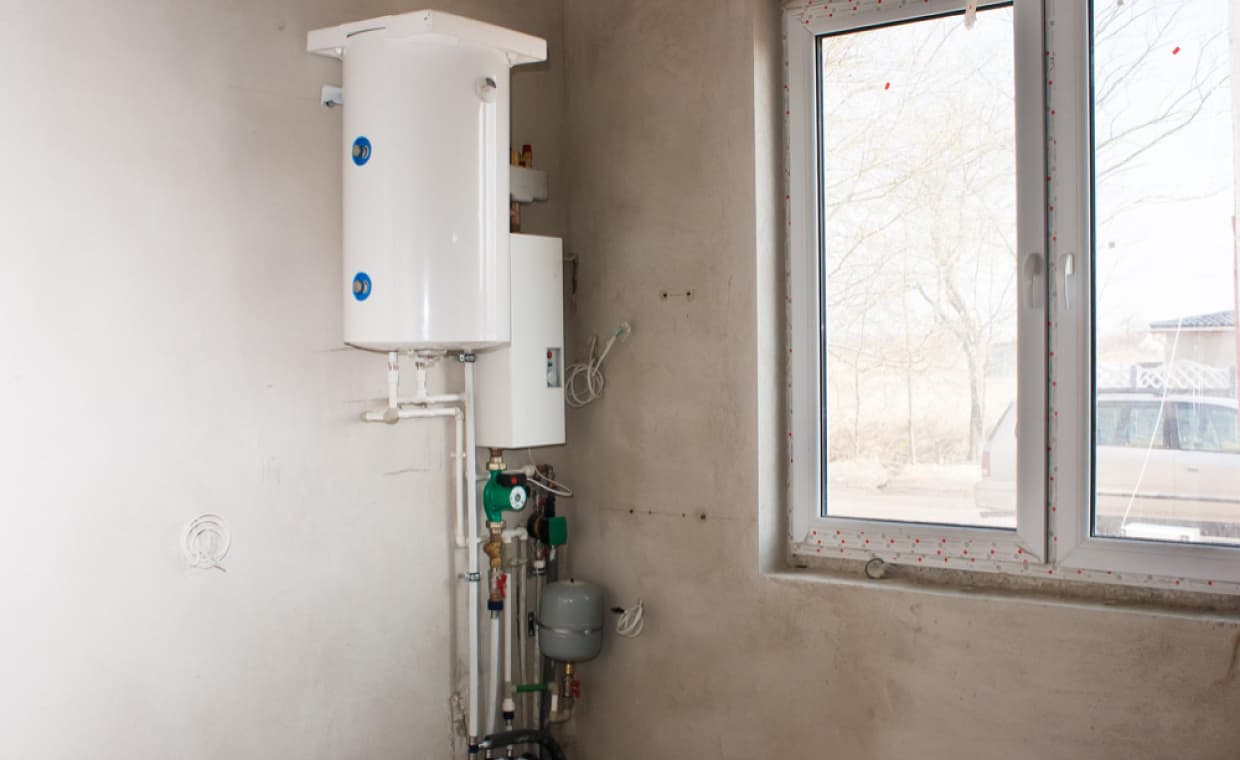
Table of Contents
Quick Summary
- Excess water pressure can damage pipes and the water heater; a water heater expansion tank can prevent this; hence it is a crucial component.
- A water heater expansion tank absorbs excess pressure using a pressurized air bladder.
- It is usually installed above the water heater or on the cold-water supply pipe.
- Key tools include a dielectric union, tee-fitting, copper pipes, sealing tape, and a wrench.
- Installation steps: Connect the union, attach the copper adapter, tee fitting, expansion pipe, and tank, and complete all connections.
- Regular maintenance involves checking the bladder and PSI pressure with a tire gauge and adjusting air levels as needed.
- Replace the tank if the bladder is ruptured or the pressure is incorrect.
- Proper installation protects plumbing, prolongs the lifespan of the water heater, and prevents costly damage.
Do you know that excess water pressure can cause your water heater tank’s pressure to rise to a dangerous level that may result in the breakage of pipes? If you knew this and yet you have not acted swiftly to correct the mess, then it can lead to extensive damage.
Well, the point is that why should you risk your plumbing system and property when you can protect them? Yes, having knowledge of how to install water heater expansion tank in your water supply plumbing will not only protect your water heater and plumbing appliances but will also prolong its lifespan.
However, if your system doesn’t have some pressure-limiting valve to keep it closed, there’s no need to install a water heater expansion tank. Let’s address a basic query first, and then go into the detail of installing a water heater expansion tank.
What is Water Heater Expansion Tank?
A water heater expansion tank is a small tank that protects fixtures in the plumbing system and pipes by absorbing water into a bladder to decrease the high pressure in the water heater.
Wondering where to install expansion tank?
Well, in most cases, an expansion tank is installed directly above the water heater or along the cold-water supply pipe. It is typically installed vertically, although it can be installed horizontally, if necessary, due to space constraints. For a better understanding, take a look at the following water heater expansion tank installation diagram.

How Does a Water Heater Expansion Tank Work?
The water heater expansion tank has a pressurized air bladder that absorbs the excess water by contracting and expanding. When the water in the heater heats up, it increases the pressure in the plumbing system and the tank and instead of letting the pressure build, the excess water enters the water heater expansion tank.
The tank doesn’t store the water permanently. It only contains overflowing water. When you open a faucet in the house, the water in the expansion tank will go back into your water heater system.
Installing a water heater expansion tank in your basement is certainly not rocket science. You only need the right tools and equipment, and you’re good to go. Basically, the water heater expansion tank installation cost depends on the size and type of expansion tank you need for your water heater.
What are the Requirements for Water Heater Expansion Tank Installation?
You would need the following tools and equipment for installing a water heater expansion tank:
- Dielectric Water Heater Nipple
- Channel-Lock Pliers Or Pipe Wrench
- Thermal Expansion Tank
- Pipe-Sealing Tape
- ¾-Inch Copper Tee-Fitting
- Copper Pipes
- Two ¾- -Inch Unions Of Copper Female-Threaded
- Plumbing Soldering Equipment (i.e. Soldering Torch, Plumbing Solder, Flux, Pipe Cutter etc.)

How to Install Water Heater Expansion Tank?
The six simple steps for mounting a water heater expansion tank are as follows –
Step 1: Attach a Dielectric Union
- Position the water heater correctly and connect the dielectric union to the entry port of the cold water.
- Using pipe-sealing tape, wrap the union threads and use a pipe wrench to thread them into the water heater’s cold water inlet.
Step 2: Attach Copper Wire
- Around the union top thread, wrap loops of pipe-sealing tape and thread a copper adapter onto the union. Then, use a pipe wrench to tighten it.
Step 3: Attach the Tee-Fitting

- Onto the adapter on the dielectric union of the water heater, install a short length of a tee-fitting and copper pipe.
- To provide the expansion tank with an adequate clearance, ensure that the tee-fitting is one foot directly above the water heater.
- When making the connections, use either sweat-soldering or push-fit links. You can also refer expansion tank plumbing diagram given in the manual.
Step 4: Attach Expansion Tank Pipe

- Use push-fit connections or sweat-soldering to connect the horizontal copper pipe on the tee-fitting to the side outlet. The copper pipe’s length would depend on the space available. However, it’s advisable to keep it as short as possible.
- Using a push-fit or sweat-soldering, connect the female threaded adapter at the horizontal pipe’s end.
Step 5: Attach the Expansion Tank
- Using a pipe-sealing tape, wrap the threaded fitting on the water heater expansion tank and screw it on the threaded adapter. Use hands to tighten threaded fittings to avoid damaging the fittings or pipes.
- If possible, install an extra valve before the expansion tank to separate the tank from the system- this will enable you to have an easy replacement when need be.
Step 6: Complete the Installation

- To complete the installation process, you have to refer to the expansion tank piping diagram given in the manual. Use a pipe to link the top outlet with the tee-fitting to the cold water supply pipe – a copper flex pipe would go a long way to make this connection.
- Also, complete the connections of the hot-water pipe to the water heater and turn the water heater on. Then, open water valves to check for leaks and to test the operation.
How to Maintain Water Heater Expansion Tank?
Now that your water heater expansion tank is installed, it would also be good to know how to maintain it to achieve its optimal operation. Below is how you can keep your water heater expansion tank working efficiently;
01. Checking the Bladder
Here is how to check your expansion tank’s bladder;
- Turn the water supply off your house and open the faucet to release the pressure.
- Take out the cap on the expansion tank and connect a gauge of tire pressure. If the pressure is not above 75 psi, then your expansion tank has failed- you’ve to replace it. However, check the water pressure if the tank has pressure inside it.
- The pressure of the water and the tank should be equal. If it is not identical, use a hand pump to add air to the water heater expansion tank.
Also, another quick and simple way to inspect your expansion tank is to check outside your expansion tank and press the Schrader valve. If water comes out after pressing the valve down, it means the bladder is raptured, and you’ll have to replace it. However, if air comes out hissing after pressing the valve, then the bladder is in good condition.
02. Checking the PSI

After confirming that the bladder is in good condition, check the tank’s psi pressure.
- Check the correct psi for your tank in your owner’s manual and if possible, write down the number on your expansion tank for future references.
- Using the tire pressure gauge, take your tank’s pressure reading. If you find that the psi is high, press the valve down to allow some air out. However, if the psi is low, use a tire pump to add some air. Avoid using an air compressor to add air to your tank as it can easily rapture the bladder. Instead, use a hand pump.
Conclusion
As you can see, installing an expansion tank is not a simple do-it-yourself task. However, the process would not be difficult if you have the proper resources and instructions.
Installing a water heater expansion tank alongside your water heater is not only a good idea but is also a requirement in many areas. Therefore, you’ve all the reasons to install one in your system.
The tankless water installation is the next in the installation series, which can be of great help to you. Go to the following link for more information –
How To Install A Tankless Water Heater – Step By Step Guide
FAQs on How to Install Water Heater Expansion Tank
1. What is the Utility of a Water Heater Expansion Tank?
A water heater expansion tank protects pipes and fixtures from excess pressure triggered by the expansion of heated water. It prevents the risk of leaks, reduces strain on the plumbing system, and extends the lifespan of your water heater.
2. What Is the Best Spot to Install a Water Heater Expansion Tank?
The expansion tank is typically installed above the water heater or on the cold-water supply line. Proper positioning ensures it can absorb extra pressure efficiently, protecting the entire plumbing system from damage.
3. How Do I Know If My Expansion Tank Is Failing?
Press the Schrader valve on the tank. If water leaks out, the bladder is ruptured, and the tank needs to be replaced. Furthermore, recurring pressure issues or pipeline leaks often indicate that the device is not properly functioning.
4. How Often Should I Check the Pressure in The Expansion Tank?
Check the expansion tank’s pressure at least twice a year. You can use a tire pressure gauge to ensure it matches your home’s water pressure. Regular checks help maintain efficiency and prevent damage to the plumbing system.
5. Can I DIY A Water Heater Expansion Tank?
Yes, you can do it, provided you have proper plumbing knowledge and hands-on skills and the right tools. Instead, it is safer to hire a licensed plumber. It ensures proper installation of the tank and also it helps avoid potential water damage.
Author Bio
Fidelis Kinai – Fidelis Muti possess a bachelor’s in English and Journalism and have over four years of professional experienced writing and proofreading materials for print and online platforms, including newspapers, magazines, websites, blogs, and social media accounts. He also have over three years of experience as a marketing assistant and social media manager.
He is versatile and diligent and will produce exemplary content within time to meet your deadline.
He can deliver most work within 2-3 days; rush orders are accepted whenever possible. He is based in the Kenya but travel often and work for clients all over the world.






























